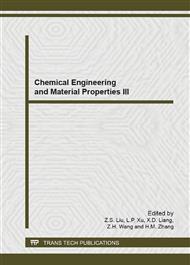[2]
Wang Bin, Ji Yuanhui. Research progress on separations ofRubidium and Cesium from saline [J]. Journal of Nanjing university of technology (NaturalScience), 2008 30(5) 104-110.
Google Scholar
[3]
Yang Zhihong, Yang Lei, Ding Youqian. Study of separation of Cs and Rb with precipitation process [J]. Journal of Nuclear and Radiochemistry, 2004 26(2) 95-113.
Google Scholar
[4]
Xu weiqiang, Ding Xingcheng. Separation of Cs-137 from reactor sediment through precipitation of caesium phosphotungstate [J]. Journal of Anqing teachers college(Natural Science) 2004 10(1) 51-52.
Google Scholar
[5]
Shi Zhengkun, Zhang Dong, Kang Houjun, et al. Study on adsorption capacity of nuclide Cs+ in the zeolite and palygorskite [J]. China Mining Magazine, 2007 16(2) 83-86.
Google Scholar
[6]
Anthony Rayford, Dosch Robert, Gu Ding, et al. Use of silicotitanates for removing cesium and strontium from defense waste [J]. Industrial & Engineering Chemistry Research, 1994 33(11) 2702-2705.
DOI: 10.1021/ie00035a020
Google Scholar
[7]
Qin yunan. The preparation and appication of new typal AMoP/SiO2 ion exchanger [J]. China Molybdenum Industry. 2001 25(5) 19-27.
Google Scholar
[8]
Michaela Petersková, César Valderrama, Oriol Gibert, et al. Extraction of valuable metal ions (Cs, Rb, Li, U) from reverse osmosis concentrate using selective sorbents [J]. Desalination, 2012 286 316-323.
DOI: 10.1016/j.desal.2011.11.042
Google Scholar
[9]
Md. Rabiul Awual. Radioactive cesium removal from nuclear wastewater by novel inorganic and conjugate adsorbents [J]. Chemical Engineering Journal, 2014 242 127-135.
DOI: 10.1016/j.cej.2013.12.072
Google Scholar
[10]
Chen Zhengyan. Impact of extraction of concentration and thinner on the extraction Rubidium, Cesium [J]. Chinese Journal of Rare Metals, 1992 6 405-410.
Google Scholar
[11]
Lu Zhi, An Lianying, Song Zhi, et al. T-BAMBP separation of Rb from high K+ brine [J]. Guangdong Trace Elements Science, 2010 17(1) 52-56.
Google Scholar
[12]
Jankowski Christopher, Dozol Jean Francois, Allain Fabrice. Use of cesium salts for detection of crown ethermacrocycles with the electrospray ionization mass spectrometry technique [J]. Polish Journal of chemistry, 2002 76(5) 701-711.
Google Scholar
[13]
Gruner Bohumir, Plesek Jaromir, Baca Jose, et al. Crown ether substituted cobalto bis(dicarbollide) ion as selective extraction agents for removal of Cs+ and Sr2+ from nuclear waste [J]. New Journal of Chemistry, 2002 26(7) 867-875.
DOI: 10.1039/b109956f
Google Scholar
[14]
Wang Jianchen, Zhu Xiaowen, Song Chongli. Extracting performance of cesium by 25, 27-bis(2-propyloxy) calix.
DOI: 10.1080/01496390500423730
Google Scholar
[4]
26, 28-crown-6 (iPr-C.
Google Scholar
[4]
C-6) in n-octanol [J]. Separation Science and Technology, 2005 40(16) 3381-3392.
Google Scholar
[15]
Du Ying, Wei Xingyao, Li Jianzhang, et al. Studies on extraction of cesium by bis-[4(5), 4c(5c)-alkanoylbenzo]-21-crown-7 [J]. Chemical Research and Application, 2004 16(3) 101-103.
Google Scholar
[16]
Sangki Chun, Sergei Dzyuba, Richard Bartsch. Influence of structural variation in room- temperature ionic liquids on the selectivity and efficiency of competitive alkali metal salt extraction by a crown ether [J]. Analytical Chemistry, 2001 73(15) 3737-3741.
DOI: 10.1021/ac010061v
Google Scholar
[17]
Luo Hemin. Sheng Dai, Peter Bonnesen, et al. Extraction of cesium ions from aqueous solutions using Calix.
Google Scholar
[4]
arene-bis (tert-octylbenzo-crown-6) in ionic liquids [J]. Analytical Chemistry, 2004 76(11) 3078-3083.
DOI: 10.1021/ac049949k
Google Scholar


